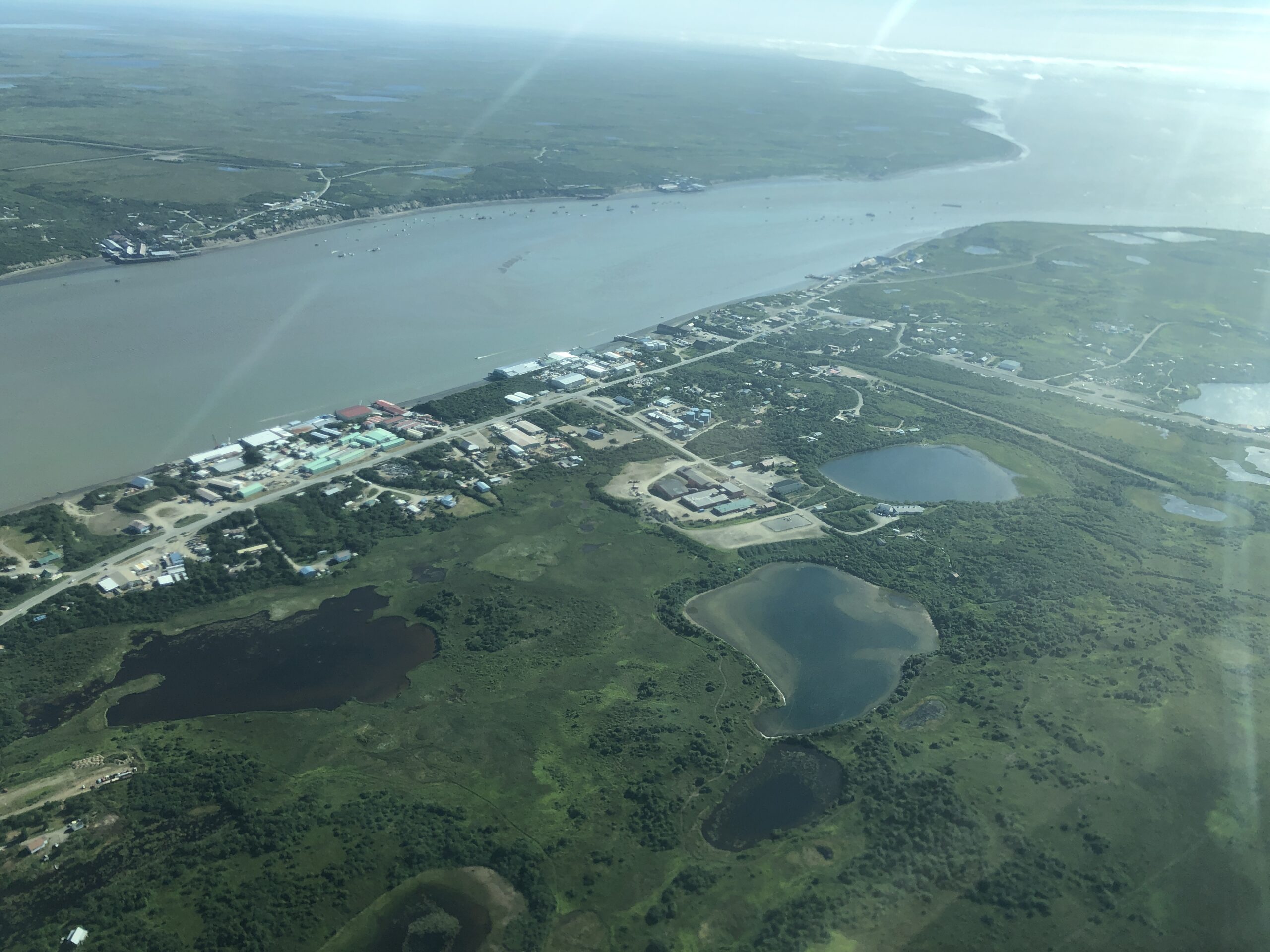Let me know if this makes sense to you.
The US Army Corps of Engineers is the federal agency responsible for ensuring that large civil engineering projects dealing with wetlands and other natural resources meet exacting specifications to ensure minimal impact on those resources.
This same agency announced on Jan. 23 that it would NOT consider a worst-case scenario tailings dam failure for the proposed Pebble Mine at the headwaters of the world’s largest wild sockeye salmon run in Bristol Bay, Alaska. Dam tailings are the highly toxic waste byproduct of open pit mining that must, in theory, be stored forever to preserve surrounding habitat. Any release of this material, which may contain arsenic, sulfur acid and other highly toxic material, could do irreparable harm to the natal streams and rivers that support the $1.5 billion economic engine driven by healthy wild salmon stocks.
Three days after this stunning announcement, Bristol Bay residents near King Salmon woke to an earthquake measuring 3.6 on the Richter scale.
So let’s do the math here. The USACE, which is supposed to ensure all of the nasty mining byproduct doesn’t leach into the landscape, ever, still feels confident nothing could go wrong.
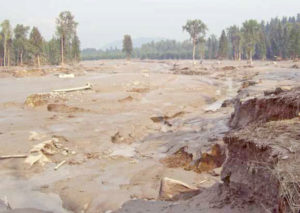
Aftermath of Mt. Polley tailings dam failure in 2014. This dam was initially engineered by the same firm slated to engineer Pebble’s tailings impoundment. What could possibly go wrong? Photo from Mining Watch/Chris Blake.
I guess it’s just a minor inconvenience that the damn tailings dam would be strategically located in a seismically active area along a geologic zone called the Ring of Fire due to constantly grating tectonic plates that force magma up through the earth’s crust and create volcanoes.
How active is it? According to the Alaska Earthquake Center, 2018 and 2019 ranked first and second respectively in the number of earthquakes tracked in Alaska, with only 50,289 reported earthquakes in 2019 ranging in depth between 0 and 165 miles. There were two quakes measuring 6.4 along the Aleutian Islands.
This would be great fodder for a Saturday Night Live skit if it weren’t so staggeringly unconscionable.
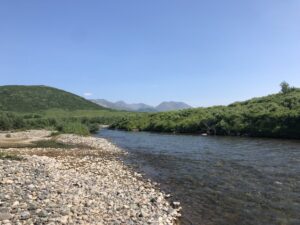
Contact Creek just south and a bit west of King Salmon in Bristol Bay. Pristine water like this is essential to salmon spawning. It could be irreversibly damaged by a tailings dam failure. USACE doesn’t seem to think that’s a possiiblity.
Frankenmine is alive…again
Credit goes to the fierce determination of the mine’s opponents that Pebble has not been permitted in the past nearly two decades since it was first proposed.
The twists and turns in the Pebble saga are dizzying. Consider:
- Three of the world’s largest four mining corporations walked away from the project, citing massive opposition and gigantic economic risks;
- A fourth, smaller potential financial backer also stepped away for the same reason in 2019;
- The Obama administration had the mine on its deathbed, concluding after years of scientific review that as initially proposed, the mine would violate the Clean Water Act and threaten precious salmon habitat;
- A 30-minute conversation between the Pebble Limited Partnership’s CEO and former EPA Administrator Scott Pruitt just a few months after the current administration took office in 2017 reversed course and put the mine back on track;
- Alaska Governor Mike Dunleavy is a Pebble Limited Partnership puppet who has publicly courted potential backers while working with President Trump to streamline and accelerate approval. In fact, you may have seen this photo of Dunleavy and Trump on Air Force One, planning more “development” that would destroy Alaska’s precious natural resources despite widespread opposition;
- Dunleavy appointed a former mining industry executive to head the state’s Department of Environmental Conservation;
- The regional EPA office publicly decried the highly questionable conclusions in the USACE draft environmental impact statement, only to be forced by the administration to walk those comments back a few days later.
- Most Alaskans don’t want the mine. Annual polls show that opposition has never dropped below 50%, and support has never risen above 40%. This despite all the money giant pro-mining corporations pour into changing opinions.
So the shaker near King Salmon had impeccable timing. It’s as if Mother Nature is rattling a warning.
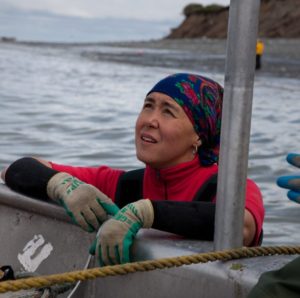
Melanie Brown on the Naknek River, doing what she loves best on the set net fishing site her great-grandfather established several decades ago.
Here’s the real worst-case scenario writ in big bold lettering so that even pro-mine “executives” in their big white offices should be able to understand. No matter how much you attempt to “store” all that toxic crap piled 500 feet high in a giant 1,000-acre “facility,” you cannot guarantee that an earthquake won’t shake it loose.
And if it does happen, and it likely would, the contamination would have an excellent chance of being near total, and potentially permanent. Thousands of people living downstream would be in danger. Wild salmon would lose their spawning grounds and the ability to ensure the longevity of the species.
I wonder what the Army Corps of Engineers would say then.
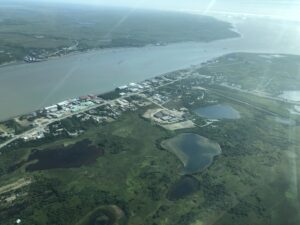
The fishing fleet in the Naknek River. The processing plants are visible along the shore. The population swells by a factor of 10 during the fishing season.
Defend Bristol Bay
For those of us in the lower 48 continuing to endure wave after wave of senseless rollbacks of environmental protections for precious natural resources across the country, the Pebble issue may seem like just another chapter in a painful narrative.
But this issue affects us all. If you eat wild salmon, you’re eating salmon that depends on crisp, clean, clear water in virtually undisturbed wilderness. Even if you don’t eat salmon, the battle to protect wild spaces is one you should care about.
I’ve met several people who have been fighting this fight for years. I’ve seen their land, their water, and their salmon. To those folks in Bristol Bay, this is a battle for their way of life – and their lives. They have no option but to continue to stand up to the blind greed, political bullying, and outright sham of the process.
We would do well to stand with them and set an example of how to change the narrative.
If you want to make your voice heard, contact your congressional representatives here. If you’d like to do more than that, check out the Defend Bristol Bay action page.
If you’d like to see what life is like in Bristol Bay for those who live and fish there, check out The Wild, the award-winning film directed by friend and colleague Mark Titus. Follow this link to see screenings near you.
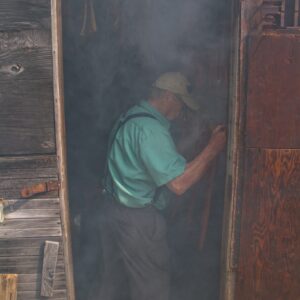
Eighty-eight-year-old Al Aspelund, an Aleut native, working his smoke shack magic as he has done for some six decades. Indigenous subsistence traditions like this are at stake.
Resources
Here are a couple of ways to get more info and get involved:
- One Fish Foundation Fish Tales Podcasts:
- Gayla Hoseth: Natural Resources Program Director and Second Chief of the Curyung Tribal Council
- Norm Van Vactor: President and CEO of Bristol Bay Economic Development Corporation
- Salmon State: Good resource for history of project and ways to get involved.
- Pebblewatch, which also has some cool maps
- National Park Service in-depth analysis of the long-term effects of tailings impoundment failures.
- Bristol Bay Native Corporation: Good background on some of the indigenous opposition to the mine.
- Bristol Bay Native Association: Another organization supporting the tribes of Bristol Bay.
- Informative Anchorage Daily News Op-Ed about how the Trump and Dunleavy administrations have worked to gut the clean water act and its protections in Alaska.
- Businesses of Bristol Bay
- Bristol Bay Economic Development Corporation
- July 1 EPA Region 10 letter from Administrator Chris Hladick, voicing concerns over Army Corps of Engineers’ Environmental Impact Statement


